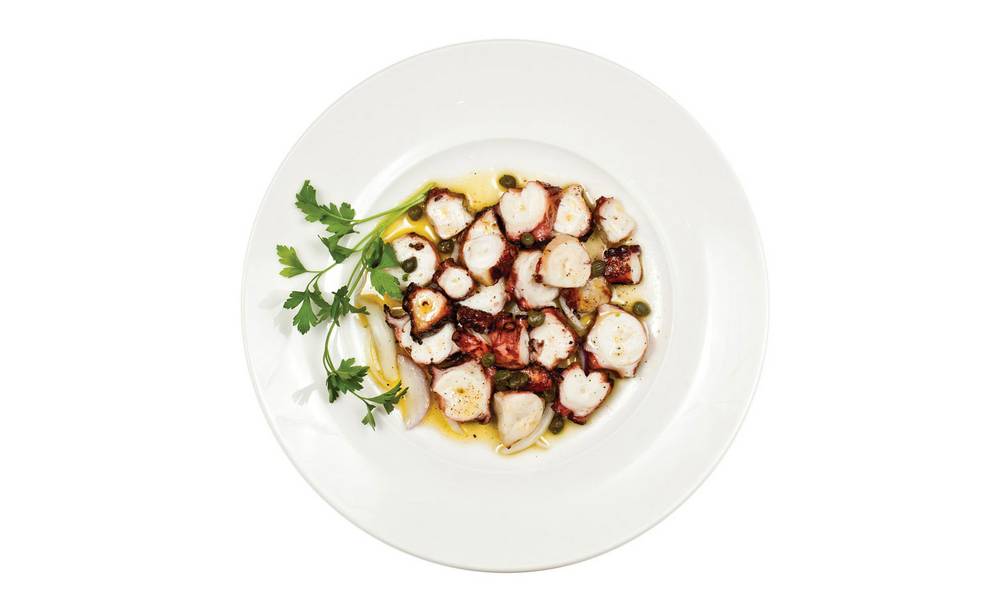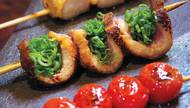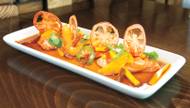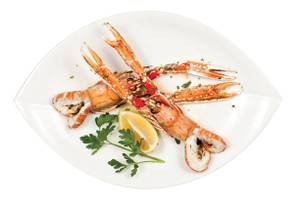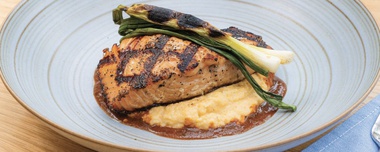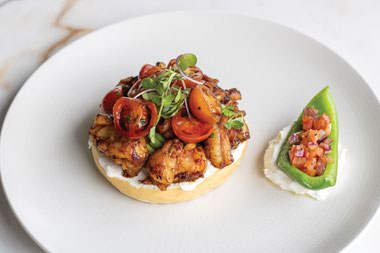There’s never been a better time to eat Las Vegas. As the Strip and the city around it have evolved, so has the Valley’s sprawling dining scene. From eat-your-way-through neighborhoods to groundbreaking restaurants, these 10 reasons are a right-now snapshot of why today truly is the Golden Age of Las Vegas dining.
1. The world's best ingredients end up on local plates
It’s a crowded Saturday night at Estiatorio Milos at the Cosmopolitan, and amid the breezy Grecian decor highlighted by clay amphorae lining the walls, customers line up at the restaurant’s fish display to choose the evening’s fare. There’s the New Zealand St. Pierre, its spiny fins belied by delicate white fillets; the hulking Canadian lobster, languidly waving its claws in the packed ice; or perhaps the Portuguese balada, a rare, coral-hued bream whose sweet, tender flesh makes it one of the eatery’s most popular offerings.
The balada takes just minutes to prepare, served crisp and unadorned, save for a coat of house olive oil from the family farm in Greece and a sprinkling of hand-shoveled sea salt from the Greek island of Kythira.
“Our philosophy is as simple as our food,” explains general manager Savvas Georgiadis. “Fresh ingredients. We try not to change the natural taste. Flavors and textures—we don’t play with those.”
Milos is one of dozens of Strip restaurants literally going to great lengths to bring the freshest, most authentic ingredients to their diners. From seafood to beef to greens, the practice of “sourcing”—culling ingredients from their naturally occurring locales—has become increasingly common at Vegas restaurants in the past five years, as the city’s dining profile has risen to compete with the likes of LA and New York. But amid the Valley's arid desert landscape, even “locally” sourced ingredients can be imported from hundreds of miles away in California, and bringing in rarer meat and seafood can be a logistical art—or nightmare.
Simplicity is Milos’ signature, but achieving it can be incredibly complex. Twenty-four hours before a balada is steaming on a customer’s plate, it’s swimming somewhere in the Mediterranean. The moment it's reeled in, a race against the clock begins. It takes six to eight hours for a fisherman to bring his catch ashore, pack it and pass it off to transporters at a local market, who load the catch into dry ice-packed boxes designed to handle the 14-hour plane trip across the Atlantic to Las Vegas.
Milos’ team is constantly in touch with its brokers, who place and collect orders from local fishermen across the globe, about the status and progress of shipments while they’re on the ground. Once the boxes hit the plane, however, deliveries are at the whim of layovers, weather and other delays. To combat the uncertainties of air travel, Milos keeps a driver on call 24/7 to pick up shipments the moment the plane taxis to the gate.
Milos brings in upwards of 300 pounds of seafood each day, with as many as 15 varieties of fish and shellfish from countries including Greece (tsipoura), Portugal (balada), Morocco (octopus) and New Zealand (St. Pierre), along with the East and Gulf coasts of the U.S. With such tenuous logistics, casualties are inevitable, and missed connections or a long delay on the ground can send orders straight to the trash.
“You can’t survive with mediocre quality,” Georgiadis says, explaining that the restaurant would rather tell a customer it's out of an item than risk serving something substandard. Even fresh fish are kept no more than two days.
Behind the Scenes at Estiatorio Milos - from YouTube.com
Mark and John Smolen, owners of Las Vegas’ Crab Corner seafood restaurants, first tapped into the sourcing trend in 2005 when they began shipping live blue crab from their native Baltimore and selling it out of their van. Demand was so high that the pair launched Nevada Seafood Wholesalers the following year.
“We realized there was a void for fresh seafood in Las Vegas,” Mark says. “We were surprised by just how many people wanted that unique product. You can’t fake a Maryland crab cake.”
Today, Nevada Seafood Wholesalers dominates the local market for live seafood, shipping from the Chesapeake Bay, Gulf Coast and Pacific Northwest and supplying dozens of grocery stores and restaurants across the country with up to 15 varieties of fish and shellfish, including 15,000 pounds of crab per week. Locally, they supply eateries like Honey Salt and Carnevino, as well as their own Crab Corner.
Like Milos, Nevada Seafood Wholesalers is a round-the-clock operation—the Smolens estimate an 18-hour sea-to-plate turnaround—with high costs and even higher risks.
“A lot of restaurants turn us down because fresh is too expensive. It’s much cheaper to get it frozen from China,” Mark says. It’s also worse for the environment. Despite the great lengths traveled for fresh ingredients, sourcing, when practiced sustainably, has a limited carbon footprint: Unlike large batch frozen orders, which are rerouted through countries like China and Kenya, where they can be cheaply processed and exported on international freight shipments, fresh sourced meat and seafood are typically sent in small orders on commercial passenger flights. As John puts it, “My crabs are next to your luggage.”
Flights alone cost $25,000 monthly, and profits are constantly at the whim of weather and public perception. The operation took a 50 percent hit in sales in the wake of Hurricane Katrina. New technology like GPS thermometer apps helps the Smolens keep tabs on shipments' freshness in real time, but even when conditions are ideal, they still lose an estimated 5 pounds of crab per 55-pound box. “It is masochistic,” John says. “Lucky for us, there’s not much we love more than fresh Maryland crab.”
For the restaurants that buy exotic seafood and other ingredients, sourcing has become essential to stand out among the competition.
“You have to do it. We spend a tremendous amount of time focused on sourcing our different items,” says Wynn Corporate Executive Chef David Snyder, who has worked in the Las Vegas restaurant industry since the late '90s. He estimates that a quarter of Wynn’s 4,000-line-item inventory is uniquely or regionally sourced, with products ranging from Ohmi beef from Japan’s Shiga Prefecture to Scottish salmon from the Shetland Isles.
Sourcing took root a decade ago with the rise of the Food Network and cooking competition shows like Top Chef. As knowledge of quality cuisine seeped into the pop culture ether, expectations heightened along the way, forcing restaurants to adjust their menus to customers' newly-discerning tastes. “Chefs started to realize, ‘I can buy the same product as [my competitor], but how am I going to lure more people into my venue?’ Tying back to where a product comes from lets you tell a story at the end of the day to your customers. As diners become more knowledgeable, they want to know how their food happened.”
Telling that story has become particularly tricky for Vegas chefs, as coastal suppliers have been tapped by restaurants closer to home and sourcing has grown fiercely competitive. Some chefs seek out premium vendors, like Wagyu cattle ranchers in small Japanese villages, and build longstanding relationships to guarantee exclusive access to a product. “Beef wars” have begun, in which chefs make high-volume orders of steak and other products to purposely create shortages for their competitors, and the same tactic is carrying over to products like seafood, exacerbating the issue of overfishing.
For restaurants like Milos, sustainability is as essential to survival as the quality of the food. Though Milos orders conservatively and according to seasonal availability, using strictly line-caught fish from small-operation fishermen, Georgiadis admits that finding certain species is already becoming difficult, and the restaurant is being forced to look for other sources. And as the practice of sourcing becomes more common, such issues are likely to increase. Snyder says shipment, quantity and other regulations will have to become part of the process to ensure a wide variety of ingredients on dinner plates for today’s eaters and the next generation.
“We’re far from a saturation point, but I think as people become more educated [sourcing] will kind of become second nature and fade into the background,” Snyder says. “From the chef to the service staff to the guest, there’s a respect for the product that trickles down.”
Back at Milos, the philosophy behind sourcing is less about keeping up with trends than it is about simple quality. “Why go so far? Because it’s better,” Georgiadis says. “Because this is how we know how to do it. Good ingredients, good food, it doesn’t need any help.”
